Indian restaurant chicken jalfrezi. Big, bold flavours. Just like they serve at your favourite Indian restaurant. Except this is one you can make it yourself.
This isn’t one of those recipes that promise to come close to Indian restaurant jalfrezi. This is the way they do it in restaurants. Seriously. Exactly like they make chicken jalfrezi in restaurants.
The whole approach might seem a little different from what you’ve seen before. That’s because it’s not fakeaway. This is the real deal. Restaurant technique. Restaurant results.
If you go for it you will surprise yourself. Could even be an “aha” moment. I know it was for me. Took me years to figure this out.
Full disclosure – this is an updated post. I’ve rewritten it, taken new pictures and added a video. But the recipe itself has not changed in any way.
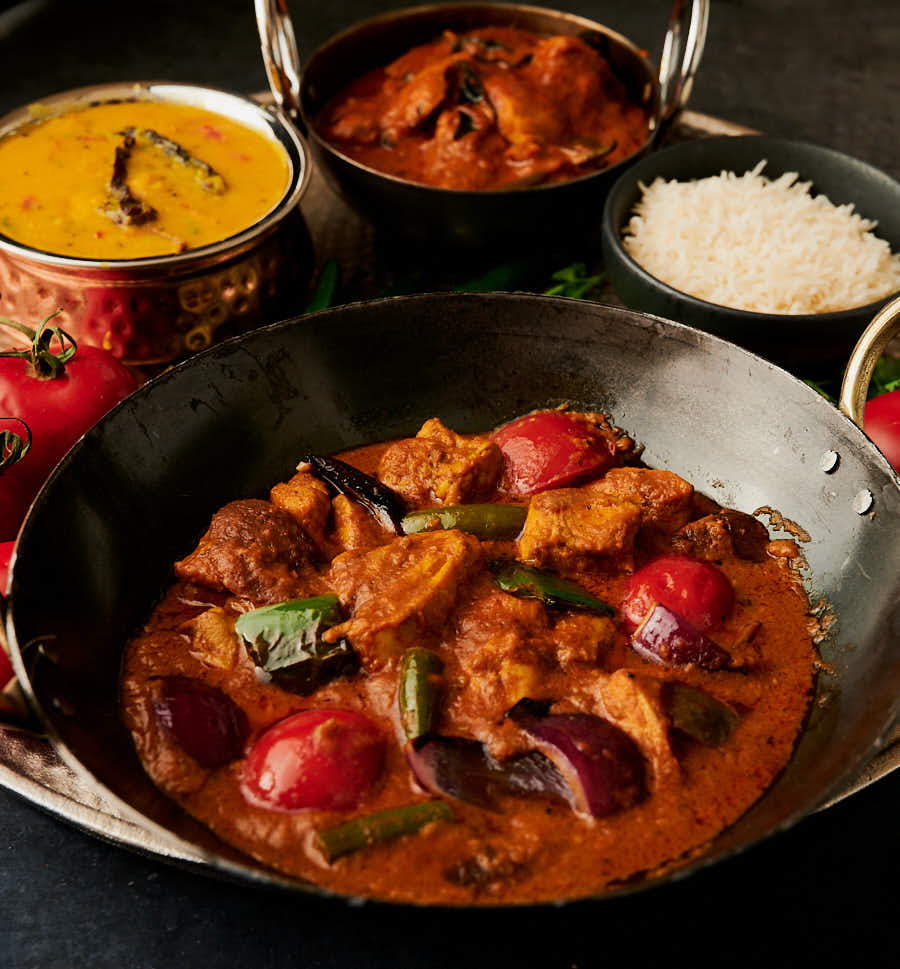
Restaurant technique for restaurant results
The first thing you need to know restaurant style is completely different. There’s no slow browning of onions. That lush sauce? It comes from using a thing called curry base.
Curry base is this kind of weak onion soup. Vaguely curry flavoured. Not particularly tasty on its own.
Bland by design really. Think of it as the canvas you paint your curries on. The spices. The chilies. The onions. The peppers. That’s how you take curry base and make a great chicken jalfrezi.
The Maillard reaction is the secret weapon here. When the curry base hits the hot oil magic happens.
Actually science happens. Amino acids, reducing sugars and heat. That generates millions of flavour compounds. It’s the same thing that happens when you brown meat. Or bake bread. It touches your life every day.
And it’s what makes restaurant style curry technique possible.
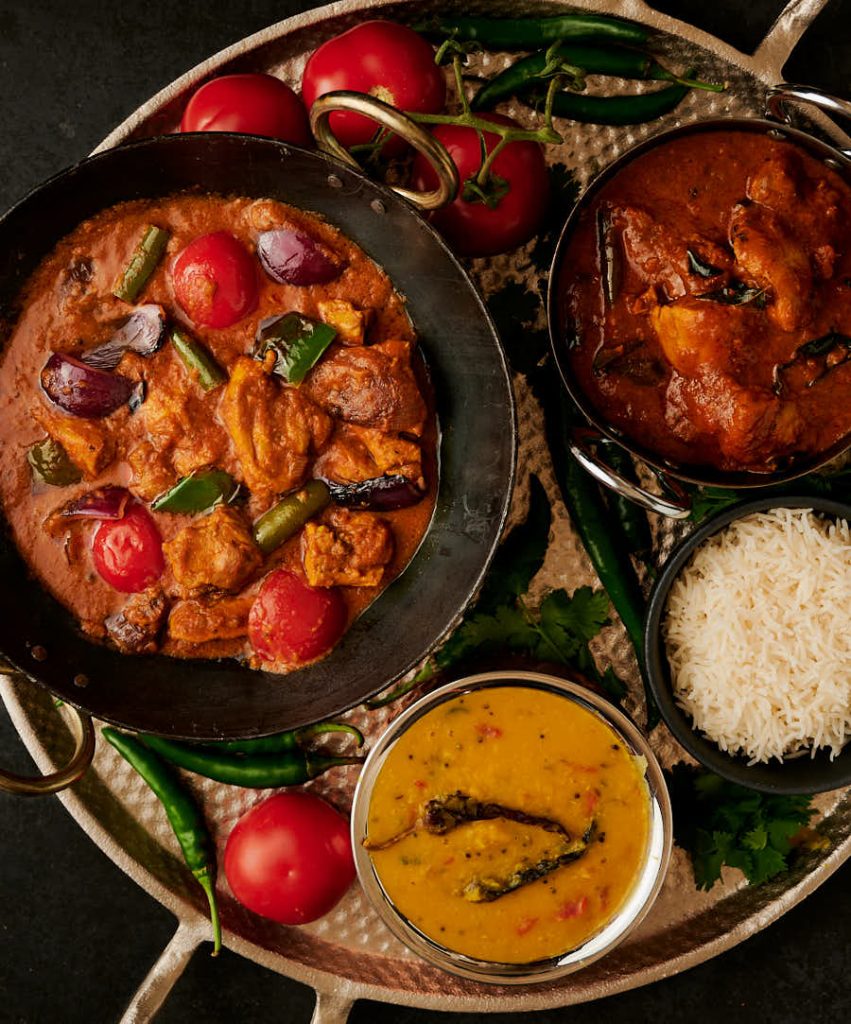
Bloom your spices for maximum flavour
Blooming spices is a fancy way of saying fry your spices in oil. That’s another key restaurant technique.
There are oil soluble flavour compounds in powdered spices. Blooming the spices extracts that flavour into the oil. And that oil carries those flavours into every bite.
That smell that wafts out of Indian restaurants as you walk by? That’s the smell of blooming spices. And it makes a big difference.
Watch your heat. If it looks like things are going sideways pick up the pan. Get it off the heat.
You need enough oil in the pan to do this. You want the spices well coated in oil. Spices bubbling in oil.
This is not diet food. And cutting back on the oil is going to get you in trouble. The spices will stick. Or burn. If you burn your spices you are starting over. There’s no fixing that.
Do it right though, and you will be making curries that amaze.
Blistered peppers make great chicken jalfrezi
I used to wonder why I didn’t always love Indian restaurant chicken jalfrezi. Sometimes it was great. A really fabulous dish. Other times I’d be asking someone to pass me the tarka dal instead.
Took me a long time to figure out what the difference was. Where the magic came from. Turns out it comes from a hint of smoky flavour. Simple once you know.
That smoky flavour comes from frying the peppers and onions hard. You want to see the skin of the peppers blister. The edges of the onions turn brown. That’s the trick. Nothing to it.
That’s what makes Indian restaurant chicken jalfrezi special. So push it a bit. Really go for it.
Restaurant style Indian cooking means restaurant prep
This is cooking restaurant style. That means 10 minutes start to finish. There’s not time to wander of to chop things once you’ve started. You need to move like they do in restaurants.
And you need to be ready like they are in restaurants. They have everything prepped and ready to go. You do to.
The French call this mise en place. That means everything in its place. Vegetables chopped. Spices measured out. Chicken pre-cooked. Curry base warming at the side.
Everything ready to go. It’s not hard if you take the time to do your prep. It’s a trainwreck waiting to happen if you don’t.
Don’t let that scare you. It’s 10 minutes of prep. And then you are good to go. It’s fun cooking this way. And the results will amaze you. Nothing here not to like.
I have some things to help you make the jump. There’s a guide to Indian restaurant technique complete with a video explaining things in detail.
You can do this. You should do this. It’s a bit of a leap. But once you’re on the other side you will never look back.
Indian restaurant chicken jalfrezi. Try it. You may never go for takeaway again…
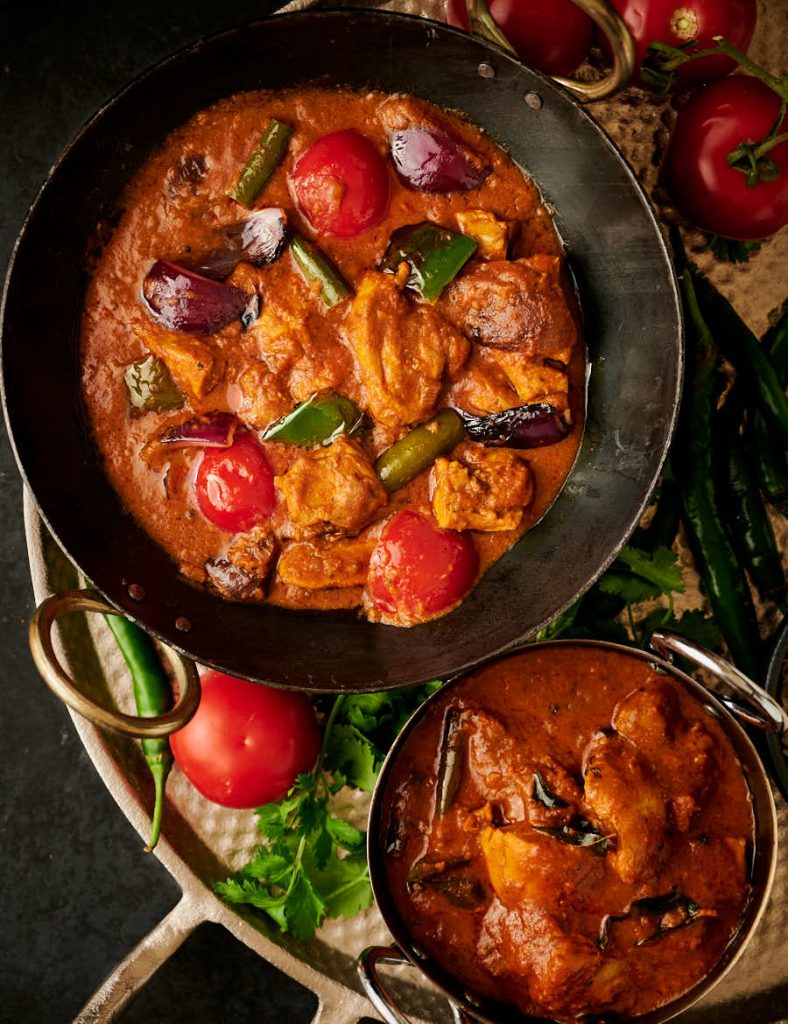
indian restaurant chicken jalfrezi
Ingredients
The spice mix
- 2 tsp indian restaurant spice mix or curry powder – recipe link below
- 1 tsp kashmiri chili powder or 1/4 tsp cayenne mixed with 3/4 tsp paprika
- 1 tsp kasoor methi – dried fenugreek leaves
- 1/2 tsp tandoori masala
- 1/2 tsp kosher salt
The curry ingredients
- 4 Tbsp neutral oil – e.g vegetable oil
- 1/2 cup coarsely chopped green pepper
- 1/2 cup coarsely chopped onion
- 1 Tbsp garlic/ginger paste – recipe link below
- 1 Tbsp tomato paste with enough water to dilute to the consistency of pasatta
- 1 Tbsp cilantro stems – finely chopped
- 15 oz curry base – recipe link below
- 10-12 oz pre-cooked chicken or lamb
- 2 finger hot green chilies cut into half then split
- 4 cherry tomatoes halved
Instructions
- Make the spice mix.
- Dilute the tomato paste with enough water to get to the consistency of passata.
- Heat your frying pan (don’t use non-stick) briefly over medium heat. Add the oil. Use all the oil specified. It’s important.
- When the oil starts to shimmer add the onions and green peppers and stir every few seconds. You want the green peppers to be skin side down as much as possible. Fry until the pepper starts to blister and the onion edges turn brown.
- Next comes the garlic ginger paste and the cilantro stems. Add them into the pan and cook it, stirring constantly, until the garlic ginger paste stops sputtering.
- Turn down the heat and add the spice mix. This is the critical step. Stir it constantly for 30 seconds. If it starts to darken lift the pan off the heat. You want the spice mix to cook in the oil but not burn.
- Turn the heat up to medium high. Add the diluted tomato paste and stir until bubbles form (the oil will likely separate). This takes around 30 seconds to one minute depending on the heat.
- Add 3 oz of curry base. Stir until bubbles form (little craters really), around 30 seconds. Watch the edges of the pan. The curry can stick here.
- Now add 6 oz of curry base and stir briefly. Let it cook until the bubbles form again. This takes 1-2 minutes.
- Add the rest of the curry base and let cook until the bubbles form. Turn the heat down to low and add the pre-cooked lamb, beef or chicken and the green chilies.
- Let the curry simmer for about 5 minutes. If it gets too thick add a bit more curry base. Don’t add water. Add the cherry tomatoes and cook until they are heated through.
- Garnish with a bit of chopped fresh cilantro and serve.

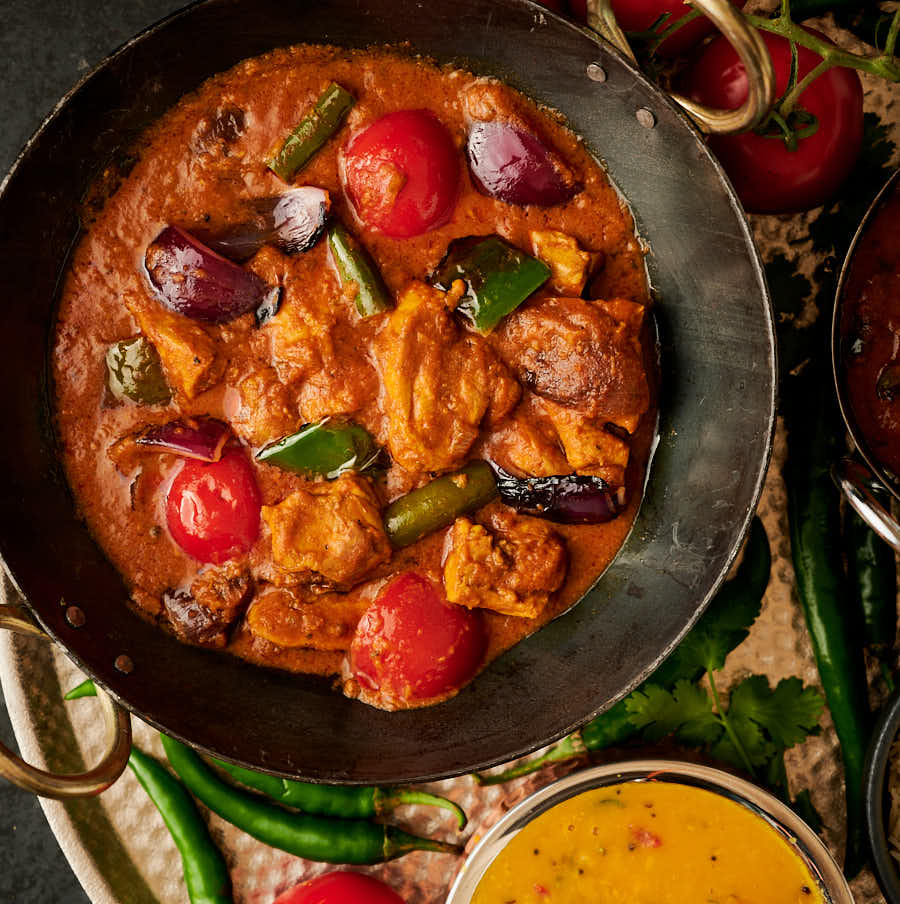
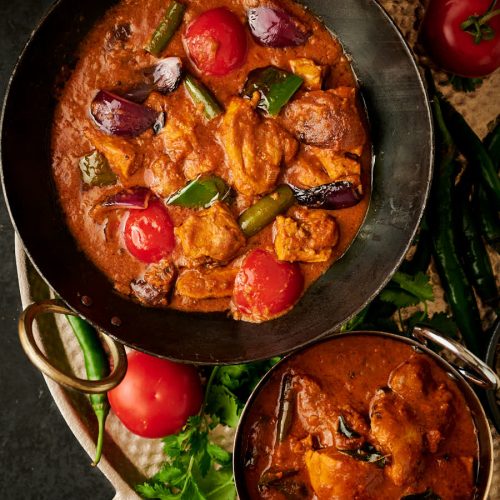
Hi Romain, been BIR dabbling a while now and your tip on blistering was an inspiration! Will be trying the tikka jalfrezi hotel style very soon. Thank you so much for taking the time to share your findings on here…away to browse more!
Hi Romain, I’ve been BIR dabbling a while now and the tip on blistering was an inspiration! Loved it will be trying the tikka jalfrezi hotel style soon- thank you so much for taking the time to share your findings!
Delighted you enjoyed it and always happy to share. Blistering was an eye opener for me too!
Really great recipe and comes out exactly like a restaurant. I lightly fry some sliced Scotch Bonnets to add a sweet and smoky flavour.
Scotch bonnets would add a lovely flavour – and some heat I bet!
I think your recipes are brilliant mate. I really like your videos too. Keep up the good work , from. Scotland 🏴👍
Thanks! That’s great to hear!
Ah, yeah I found that one now. Very good video.
Another thing. I got really, really thirsty after I ate my first batch of indian food from one of these recipes, using curry base and all of that good stuff. 🙂
Do you think that is just me being unused to very spicy food? Or do you think I perhaps did something wrong, which made the course really water absorbing or something? Perhaps too much spices and too dry chicken?
I don’t expect you to necessarily know the answer to this but maybe you have some tips.
Thirsty makes me think salt. All the recipes on glebekitchen call for kosher salt. It is a coarser salt so less sodium by volume. If you are using regular table salt you should use about 2/3 of the specified amount.
Hi
I have noticed that when I precook chicken-filets, which I do in a broth that I save for chicken soup, they often become quite dry, after I have taken them out of that cooking water.
I store them in the fridge for a day or two, after I have cooked them, until I make indian food with those filets. But they become a bit dry I think.
Is there any way around this? Is it possible to make them more moist somehow in, or after, the cooking process?
If you check my YouTube channel I cover pre-cooking chicken in a video there.
Thighs are much more forgiving than white meat for starters. Beyond that I can suggest 2 things.
1) Dry brine your chicken. This gives you a little buffer in terms of potentially overcooking.
2) Cook to a target internal temperature of no more than 160F for white and 170F for dark. You can even go a little lower.
Hi Romain I’m going to try this jalfrezi dish for the first time, if I wanted to to make tikka style how would I do this without a tandoori oven?
Andrew
I usually use a BBQ but if that’s not an option I like to roast the chicken in a 400F oven. You don’t need to skewer them or anything. Just put them on a sturdy, pre-heated baking sheet. Shake off the excess tandoori marinade. Make sure there is room between the pieces. Roast for about 5 minutes and them flip. Cook another few minutes (until the chicken registers about 160F for breast or 170F for dark). If you like, the juices in the pan make a nice bit of extra flavour when added to the dish. Just be sure to watch your salt.
The best jalfrezi I’ve made wonderful flavours I will be checking out all other curries Thank You
Thank you! I’m glad you enjoyed it and I hope you find lots of other things to cook here.
Hi, I want to try this, it sounds delicious. And since I already made the curry base, I’m ready to go. I have one question though: you insist on not using a non-stick pan. I’m not going to ask why (it’s kinda obvious), but I don’t really have one. All I have is non-stick pans plus a tiny steel pot (definitely too small, I guess) and a cast iron pan. Can/should I use the latter? Or would that ruin the patina on it? Normally we use it for steaks and fried eggs.
Cast iron is tricky because it’s a big thermal mass and so isn’t responsive. You can run into trouble when you add the spices if the pan is too hot. I’d go with non-stick in your case. Once you get comfortable with the technique you could try cast iron. Or maybe invest in a cheap aluminium pan from a restaurant supply store if you get into it.
As far as the patina goes – I wouldn’t risk that for anything.
Hi Romain,
Just wanted to let you know that enameled cast iron does work well with cooking the curry. It might take a bit more time to bloom the spices, and you definitely have to turn down (or off) the flame, lest you burn the spices, but I get consistent flavor each time. EVerything does take a little longer as the pot is much less responsive than a 3-layer aluminium pan.
The curry discolors the enamel slightly, but it isn’t a matter for me.
Thanks for the recipes!
That’s impressive. It’s tricky working with something that moves that slowly thermally. I can do it with a stainless pan but I find cast iron pretty difficult.
My challenge is heating up the cast iron enough to get it hot enough to really fry the curry base without burning the spices. I do homestyle/traditional in enamelled cast iron but restaurant style in something I’m still not really able to do do well.
My enamelled cast iron pots are well discoloured by now as well. Badge of honour I think :-).
Hi Romain, love your recipes – all without exception producing excellent tasting food, with clear easy to follow instructions. Thank you. I wondered if you had any plans to bring these together and publish in a book? Regards
Thank you for saying. I’m glad you’re finding things you enjoy cooking here.
I’m getting asked that more and more but I work full time and glebekitchen is my hobby so I just don’t have the time to put together a book right now.
Before leaving the UK some 23 years ago to live in California i used to regularly eat at The Taste of Raj in Richmond Surrey. My favorite dish was Chicken Jalfrezi and i have never been able to find a restaurant in the USA that can replicate that amazing taste. Even the Vindaloo and Phall curry’s are mild compared to the UK versions ? I have used this recipe a few times and it comes near to replicating the restaurant taste i do add some extra green chilies to bring the heat level up to my requirements.
Glad you like it. Almost everything is spiced medium hot on glebekitchen so people can turn the heat up if they desire. More green chilies, a hot chili powder instead of Kashmiri or even a little bit of naga pickle should fix you right up. Note that the naga pickle will change the flavour profile as well.
Hi can I just ask what oil you use it says its important but I can’t find what type in the recipe
Thank you for bringing that to my attention. I though I’d specified in all the recipes but I missed this one. Any neutral oil works. Personally I use canola.
Tried the chicken jalfresi twice now, but each time it has turned out very thin and runny. How can I thicken it up?
I’m going to assume you are using the curry base from glebekitchen, pre-cooking your chicken and not trying to double or triple the recipe. If you are all these then I would guess you aren’t frying your dish hard enough when you are adding the curry base.
The restaurant technique relies on really pushing the contents of the pan to generate the Maillard compounds that are key to the flavour development. Evaporation is a by-product and thickens the base to a restaurant curry consistency. Not pre-cooking the chicken results in the liquid thrown by the chicken diluting the curry. Doubling or tripling makes it very hard to push the frying hard as there is so much curry base over the same surface area in your pan.
I’ve made literally hundreds (and possibly thousands) of curries using these techniques and I have never once had one turn out runny. Quite the opposite. Sometimes I need to add a bit of base at the end to thin the curry down.
Thank you. Ill try that next time.
have cooked this twice. Makes me feel like a champion indian chef!
So delicious…. and recipe so precise.
I love it!
thank you
PS the curry base is essential
You are very welcome. Glad you are enjoying it!